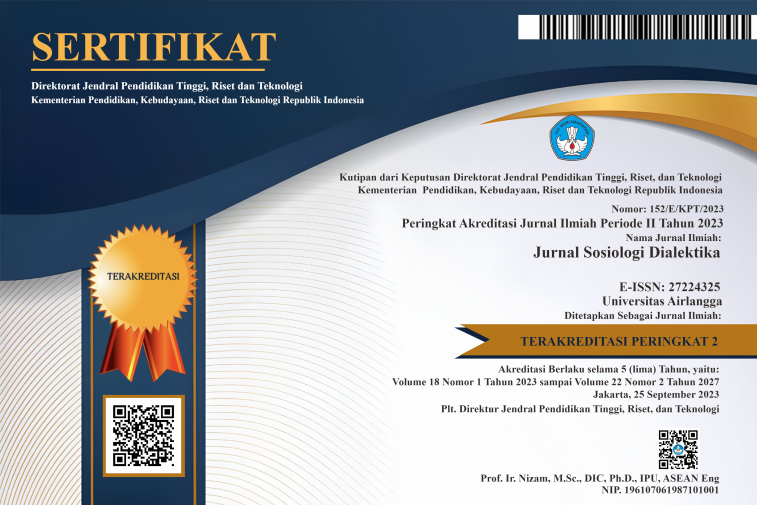Healthy behavior and herbal drink consumption among educated youth during COVID-19 pandemic
Downloads
The coronavirus (COVID-19) pandemic has affected social and economic sectors and has created new behavior and lifestyles. This article employs a quantitative methodological approach. Through interviews with 274 university students in East Java, Indonesia, the findings suggest that young people's awareness of health behavior shifted after the spread of COVID-19. Before the pandemic, parents are struggling to have their children consume herbs. Youngsters consider herbs as a traditional lifestyle for the elderly. However, after COVID-19, the results suggest that young people are more supportive of herbal medicine in order to protect themselves from COVID-19. Therefore, it can be argued that COVID-19 pandemic generates a growing awareness for young people to consume herbal medicine, which becomes a new lifestyle and preserves the nation's centuries-worth wisdom of the local culture.
Adnani H, Subiyanto AA, Hanim D, & Sulaeman ES (2018) Health promotion in clean and healthy behavior programs in traditional markets. International Research Journalof Management, IT & Social Sciences 5 (4):46-52.
Anderson JL, Warren CA, Perez E, Louis RI, Phillips S, Wheeler J, Cole M, & Misra R (2008) Gender and ethnic differences in hand hygiene practices among college students. American Journal of Infection Control 36 (5):361-368. https://doi.org/10.1016/j.ajic.2007.09.007.
Antons C & Antons-Sutanto R (2009) Traditional Knowledge, Traditional Cultural Expressions and Intellectual Property Law in the Asia-Pacific Region, Alphen aan den Rijn. Kluwer Law International. 363-384.
Azagba S, Langille D, & Asbridge M (2014) An emerging adolescent health risk: Caffeinated energy drink consumption patterns among high school students. Preventive Medicine 62: 54-59. https://doi.org/10.1016/j.ypmed.2014.01.019.
Ball K, Jeffery RW, Abbott G, McNaughton SA, & Crawford D (2010). Is healthy behavior contagious: Associations of social norms with physical activity and healthy eating. International Journal of Behavioral Nutrition and Physical Activity 7 (1):86. https://doi.org/10.1186/1479-5868-7-86.
Blumenthal KJ, Saulsgiver KA, Norton L, Troxel AB, Anarella JP, Gesten FC, Charnew ME, & Volpp KG (2013) Medicaid incentive programs to encourage healthy behavior show mixed results to date and should be studied and improved. Health Affairs 32 (3):497-507. https://doi.org/10.1377/hlthaff.2012.0431.
Boswell GH, Kahana E, & Dilworth-Anderson P (2006) Spirituality and healthy lifestyle behaviors: Stress counter-balancing effects on the well-being of older adults. Journal of Religion and Health 45 (4):587-602. https://doi.org/10.1007/s10943-006-9060-7.
Campo S, Cameron KA, Brossard D, & Frazer MS (2004) Social norms and expectancy violation theories: Assessing the effectiveness of health communication campaigns. Communication Monographs 71 (4):448-470. https://doi.org/10.1080/0363452042000307498.
Demeke CA, Woldeyohanins AE, & Kifle ZD (2021) Herbal medicine use for the management of COVID-19: A review article. Metabolism Open 12: 100141.
Domar AD, Conboy L, Denardo-Roney J, & Rooney KL (2012) Lifestyle behaviors in women undergoing in vitro fertilization: a prospective study. Fertility and Sterility 97 (3):697-701. https://doi.org/10.1016/j.fertnstert.2011.12.012.
Engbers LH, van Poppel MN, Chin A Paw M, & van Mechelen W (2006) The effects of a controlled worksite environmental intervention on determinants of dietary behavior and self-reported fruit, vegetable and fat intake. BMC Public Health 6 (1). https://doi.org/10.1186/1471-2458-6-253.
Fournier AK & Berry TD (2012) Effects of response cost and socially-assisted interventions on handhygiene behavior of university students. Behavior and Social Issues 21: 152-164. https://doi.org/10.5210/bsi.v21i0.3979.
Gardiner P, Kemper KJ, Legedza A, & Phillips RS (2007) Factors Associated with herb and dietary supplement use by young adults in the United States. BMC Complementary and Alternative Medicine 7 (1). https://doi.org/10.1186/1472-6882-7-39.
Garg A, Taneja DK, Badhan SK, & Ingle GK (2020) Impact of a school-based hand washing promotion program on knowledge and hand washing behavior of girl students in a middle school of Delhi. Indian Journal of Public Health 57 (2):109-112.
Gerber BS, Stolley MR, Thompson, AL, Sharp LK, & Fitzgibbon ML (2009) Mobile phone text messaging to promote healthy behaviors and weight loss maintenance: a feasibility study. Health Informatics Journal 15 (1):17-25. https://doi.org/10.1177/1460458208099865.
Hardon A & Ilmi Idrus N (2015) Magic power: Changing gender dynamics and sex-enhancement practices among youths in Makassar, Indonesia. Anthropology & Medicine 22 (1):49-63. https://doi.org/10.1080/13648470.2015.1010114.
Heckman MA, Sherry K, & De Mejia EG (2010) Energy drinks: An assessment of their market size, consumer demographics, ingredient profile, functionality, and regulations in the United States. Comprehensive Reviews in Food Science and Food Safety 9 (3):303-317. https://doi.org/10.1111/j.1541-4337.2010.00111.x.
Huang T, Harris KJ, Lee RE, Nazir N, Born W, & Kaur H (2003) Assessing overweight, obesity, diet, and physical activity in college students. Journal of American College Health 52 (2):83-86. https://doi.org/10.1080/07448480309595728.
Iyadurai SJP & Chung SS (2007) New-onset seizures in adults: Possible association with consumption of popular energy drinks. Epilepsy & Behavior 10 (3):504-508. https://doi.org/10.1016/j.yebeh.2007.01.009.
Keller PA (2014) Social Marketing and Healthy Behavior. Forthcoming in the Handbook of Persuasion and Social Marketing. In: Stewart DW (ed). Marketing. New York: Routledge.
Lesmayati S, Qomariah R, & Pramudyani L (2021) The impact of COVID-19 pandemic on people's behavior and herbal drink (jamu) processing businesses in Banjarbaru, South Kalimantan. E3S Web of Conferences. EDP Sciences. 306.
Loewenstein G, Brennan T, & Volpp KG (2007) Asymmetric paternalism to improve health behaviors. JAMA 298 (20):2415-2417. https://doi.org/10.1001/jama.298.20.2415.
Lopez-Quintero C, Freeman P, & Neumark Y (2009) Hand washing among school children in Bogotá, Colombia. American Journal of Public Health 99 (1):94-101. https://doi.org/10.2105/ajph.2007.129759.
Lumpkins CY, Greiner KA, Daley C, Mabachi NM, & Neuhaus K (2011) Promoting healthy behavior from the pulpit: Clergy share their perspectives on effective health communication in the African American Church. Journal of Religion and Health 52 (4):1093-1107. https://doi.org/10.1007/s10943-011-9533-1.
Mangestuti S, Widyawaruyanti A, Zaidi SFH, & Awale A, & Kadota S (2007) Traditional medicine of Madura Island in Indonesia. Journal of Traditional Medicine 24 (3):90-103.
Mann J, Zhou H, McDermott S, & Poston MB (2006) Healthy behavior change of adults with mental retardation: Attendance in a health promotion program. American Journal on Mental Retardation 111 (1):62. https://doi.org/10.1352/0895-8017.
Margolis R (2013) Educational Differences in healthy behavior changes and adherence among middle-aged americans. Journal of Health and Social Behavior 54 (3):353-368. https://doi.org/10.1177/0022146513489312.
Maron DJ, Mancini GJ, Hartigan, PM, Spertus JA, Sedlis SP, Kostuk WJ, & COURAGE Trial Group. (2018) Healthy behavior, risk factor control, and survival in the COURAGE trial. Journal of the American College of Cardiology 72 (19):2297-2305.
Martin Hilber A, Hull TH, Preston-Whyte E, Bagnol B, Smit J, Wacharasin C, & Widyantoro N (2010) A cross cultural study of vaginal practices and sexuality: Implications for sexual health. Social Science & Medicine 70 (3):392-400. https://doi.org/10.1016/j.socscimed.2009.10.023.
McBryde ES, Bradley LC, Whitby M, & McElwain DLS (2004) An investigation of contact transmission of methicillin-resistant Staphylococcus aureus. Journal of Hospital Infection 58 (2):104-108. https://doi.org/10.1016/j.jhin.2004.06.010.
Miller KE (2008) Energy drinks, race, and problem behaviors among college students. Journal of Adolescent Health 43(5): 490–497. https://doi.org/10.1016/j.jadohealth.2008.03.003.
Mollen S, Rimal RN, Ruiter RAC, & Kok G (2013) Healthy and unhealthy social norms and food selection. Findings from a field-experiment. Appetite 65: 83-89. https://doi.org/10.1016/j.appet.2013.01.020.
Nelson MC & Story M (2009) Food environments in University Dorms. American Journal of Preventive Medicine 36 (6):523-526. https://doi.org/10.1016/j.amepre.2009.01.030.
Nelson MC, Lust K, Story M, & Ehlinger E (2008) Credit card debt, stress and key health risk behaviors among college students. American Journal of Health Promotion 22 (6):400-406. https://doi.org/10.4278/ajhp.22.6.400.
O'Brien MC, McCoy TP, Rhodes SD, Wagoner A, & Wolfson M (2008) Caffeinated cocktails: Energy drink consumption, high-risk drinking, and alcohol-related consequences among college students. Academic Emergency Medicine 15 (5):453-460. https://doi.org/10.1111/j.1553-2712.2008.00085.x.
O'Flaherty S, Ross RP, Meaney W, Fitzgerald GF, Elbreki MF, & Coffey A (2005) Potential of the polyvalent anti-staphylococcus bacteriophage k for control of antibiotic-resistant staphylococci from hospitals. Applied and Environmental Microbiology 71 (4):1836-1842. https://doi.org/10.1128/aem.71.4.1836-1842.2005.
Paek H-J, Lee B, Salmon CT, & Witte K (2006) The contextual effects of gender norms, communication, and social capital on family planning Behaviors in Uganda: a multilevel approach. Health Education & Behavior 35 (4):461-477.https://doi.org/10.1177/1090198106296769.
Purpura S, Schwanda V, Williams K, Stubler W, & Sengers P (2011) Fit4life: the design of a persuasive technology promoting healthy behavior and ideal weight. In: Proceedings of the SIGCHI conference on human factors in computing systems. 423-432. https://doi.org/10.1145/1978942.1979003.
Purwaningsih EH (2013) Jamu, obat tradisional asli indonesia pasang surut pemanfaatannya di Indonesia. E-Journal Kedokteran Indonesia 1 (2):85-89.
Rath M (2012) Energy drinks: What is all the hype? The dangers of energy drink consumption. Journal of the American Academy of Nurse Practitioners 24 (2):70-76. https://doi.org/10.1111/j.1745-7599.2011.00689.x.
Reuter T & Renner B (2011) Who takes precautionary action in the face of the new H1N1 influenza? Prediction of who collects a free hand sanitizer using a health behavior model. PLoS ONE 6 (7):e22130. https://doi.org/10.1371/journal.pone.0022130.
Reyes Fernández B, Knoll N, Hamilton K, & Schwarzer R (2016) Social-cognitive antecedents of hand washing: Action control bridges the planning–behaviour gap. Psychology & Health 31 (8):993-1004. https://doi.org/10.1080/08870446.2016.1174236.
Rothman AJ, Bartels RD, Wlaschin J, & Salovey P (2006) The strategic use of gain- and loss-framed messages to promote healthy behavior: How theory can inform practice. Journal of Communication 56 (suppl_1):S202-S220. https://doi.org/10.1111/j.1460-2466.2006.00290.x.
Sangat HM & Larashati, I. (2002) Some ethnophytomedical aspects and conservation strategy of several medicinal plants in Java, Indonesia. Biodiversitas 3 (2):231-235.
Seifert SM, Schaechter JL, Hershorin ER, & Lipshultz SE (2011) Health effects of energy drinks on children, adolescents, and young adults. PEDIATRICS 127 (3)511-528. https://doi.org/10.1542/peds.2009-3592.
Septiadi D, Maulyda MA, & Widodo A (2020) The use of medicinal plants during the COVID-19 pandemic: perspective of literacy and consumption interests for millennial generation. Jurnal Agribisnis Terpadu 13 (2):205-221.
Sogari G, Velez-Argumedo C, Gómez M, & Mora C (2018) College Students and Eating Habits: A study using an ecological model for healthy behavior. Nutrients 10 (12):1823. https://doi.org/10.3390/nu10121823.
Song IH, Kim S-A, & Park W-S (2012) Family factors associated with children's handwashing hygiene behavior. Journal of Child Health Care 17 (2):164-173. https://doi.org/10.1177/1367493512456106.
Spierer DK, Blanding N, & Santella A (2013) Energy drink consumption and associated health behaviors among university students in an urban setting. Journal of Community Health 39 (1):132-138. https://doi.org/10.1007/s10900-013-9749-y.
Susanti B, Situmorang HY, & Virginia G (2019) RDFS-based information representation of Indonesian traditional jamu. In Lecture Notes in Engineering and Computer Science: Proceedings of The International MultiConference of Engineers and Computer Scientists.13-15.
Sutakwa A & Wiratara PRW (2022) Herbal products and food supplements consumption and belief during the COVID-19 pandemic: A study in Java Island, Indonesia. Jurnal Agercolere 4 (1):1-13.
Thombs DL, O'Mara RJ, Tsukamoto M, Rossheim ME, Weiler RM, Merves ML, & Goldberger BA (2010) Event-level analyses of energy drink consumption and alcohol intoxication in bar patrons. Addictive Behaviors 35 (4):325-330. https://doi.org/10.1016/j.addbeh.2009.11.004.
Thrasher JF, Campbell MK, & Oates V (2004) Behavior-Specific social support for healthy behaviors among African American Church members: Applying optimal matching theory. Health Education & Behavior 31 (2):193-205. https://doi.org/10.1177/1090198103259184.
Torri MC (2012a) The JAMU system in Indonesia: Linking smallscale enterprises, traditional knowledge and social empowerment among women in Indonesia. Journal of International Women's Studies 13 (1):32-45.
Torri MC (2012b) The emergence of traditional Indonesian herbal medicine (jamu) for cosmetic use: New avenues for the revitalisation of Javanese health and cosmetic traditions through gender entrepreneurship? International Journal of Entrepreneurship and Small Business 16 (1):48. https://doi.org/10.1504/ijesb.2012.046916.
Ussher MH, Taylor AH, & Faulkner GEJ (2014) Exercise interventions for smoking cessation. Cochrane Database of Systematic Reviews. https://doi.org/10.1002/14651858.cd002295.pub5.
Whitby M, McLaws M-L, & Ross MW (2006) Why healthcare workers don't wash their hands: a behavioral explanation. Infection Control & Hospital Epidemiology 27 (5):484-492. https://doi.org/10.1086/503335.
White C, Kolble R, Carlson R, & Lipson N (2005) The impact of a health campaign on hand hygiene and upper respiratory illness among college students living in residence halls. Journal of American College Health 53 (4):175-181. https://doi.org/10.3200/jach.53.4.175-181.
Widyowati R & Agil M (2018) Chemical constituents and bioactivities of several Indonesian plants typically used in jamu. Chemical and Pharmaceutical Bulletin 66 (5):506-518. https://doi.org/10.1248/cpb.c17-00983.
Yang Z & Hall AG (2007). The financial burden of overweight and obesity among elderly americans: The dynamics of weight, longevity, and health care cost. Health Services Research 43 (3):849-868. https://doi.org/10.1111/j.1475-6773.2007.00801.x.
Yun D & Silk KJ (2011) Social norms, self-identity, and attention to social comparison information in the context of exercise and healthy diet behavior. Health Communication 26 (3):275-285. https://doi.org/10.1080/10410236.2010.549814.

This work is licensed under a Creative Commons Attribution-NonCommercial-ShareAlike 4.0 International License.
1. Copyright of this journal is possession of Editorial Board and Journal Manager, by the knowledge of author, whilst the moral right of the publication belongs to the author.
2. Legal formal aspect of journal publication accessibility refers to Creative Commons Attribution-NonCommercial-ShareAlike (CC BY-NC-SA), implies that publication can be used for non-commercial purposes in its original form (cannot be modified).
3. Every publications (printed/electronic) are open access for educational purposes, research, and library. Other that the aims mentioned above, editorial board is not responsible for copyright violation.















